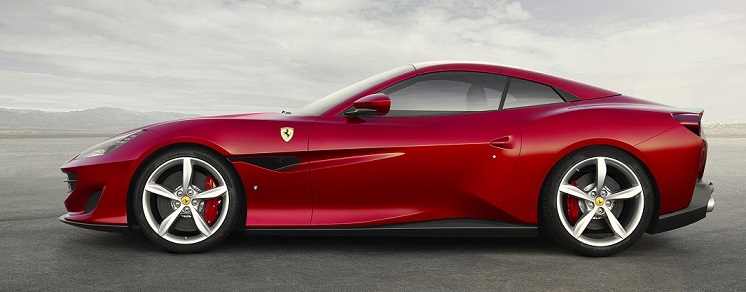

Convertible, 2 Doors, 4 Seats
10.7 l/100 km 21.98 US mpg
600 Hp @ 7500 rpm.
155.6 Hp/l
320 km/h 198.84 mph
3855 cm3
235.25 cu. in.
8, V-engine
Rear wheel drive,
4586 mm
180.55 in.
1938 mm
76.3 in.
1545 kg
3406.14 lbs.
| Brand | Ferrari |
|---|---|
| Model | Portofino (Convertible) |
| Version | Portofino |
| Engine version | 3.9 V8 (600 Hp) DCT |
| Year production start | 2017 |
| Year production end | 2020 |
| Vehicle type | Convertible |
| Horsepower RPM | 600 Hp @ 7500 rpm. |
| Acceleration 0 - 100 kmh sec | 3.5 sec |
| Curb weight kg -lbs total |
1545 kg3406.14 lbs. |
| Overall length mm - inch |
4586 mm180.55 in. |
| Doors | 2 |
| Top Speed | 320 km/h 198.84 mph |
| Designation model | F154BE |
|---|---|
| Engine position and orientation | Front, Longitudinal |
| Cylinders | 8 |
| Position of cylinders | V-engine |
| Displacement (liters) |
3855 cm3235.25 cu. in. |
| Eng. horsepower RPM | 600 Hp @ 7500 rpm. |
| Horsepower per litre | 155.6 Hp/l |
| Weight / horsepower kg/hp - hp/tons |
2.6 kg/Hp388.3 Hp/tonne |
| Weight / torque kg/Nm - Nm/tons | 2 kg/Nm, 491.9 Nm/tonne
2 kg/Nm491.9 Nm/tonne |
| Torque Nm RPM lb-ft RPM |
760 Nm @ 3000-5250 rpm.560.55 lb.-ft. @ 3000-5250 rpm. |
| Bore (mm in) |
86.5 mm3.41 in. |
| Stroke (mm in) |
82 mm3.23 in. |
| Compression ratio | 9.45 |
| Fuel delivery system | Direct injection |
| Fuel type | Petrol (Gasoline) |
| Valvetrain | 4 |
| Engine aspiration | BiTurbo, Intercooler |
| Engine oil liters | quarts |
13-14.5 l13.74 - 15.32 US qt | 11.44 - 12.76 UK qt |
| Engine coolant |
21 l22.19 US qt | 18.48 UK qt |
| Powertrain architecture | Internal Combustion engine |
| Engine location | Front, Longitudinal |
| Drive configuration | Rear wheel drive |
|---|
| Front brakes | Ventilated discs |
|---|---|
| Rear brakes | Ventilated discs |
| Anti-lock brake system | ABS (Anti-lock braking system) |
| Steering type | Steering rack and pinion |
|---|
| Wheels size | 245/35 ZR20; 285/35 ZR20 |
|---|---|
| Wheels rims | 8J x 20; 10J x 20 |
| Passengers seats | 4 |
|---|---|
| Trunk space min liter | cu. Ft. |
292 l10.31 cu. ft. |
| Overall length mm - inch |
4586 mm180.55 in. |
|---|---|
| Overall width mm -inch |
1938 mm76.3 in. |
| Overall height mm -inch |
1318 mm51.89 in. |
| Wheelbase mm - inch |
2670 mm105.12 in. |
| Track width front mm - inch |
1633 mm64.29 in. |
| Track width rear mm - inch |
1635 mm64.37 in. |
| Curb weight kg -lbs total |
1545 kg3406.14 lbs. |
|---|---|
| Fuel tank liters | gallons |
80 l21.13 US gal | 17.6 UK gal |
| Combined l/100 km - Mpg |
10.7 l/100 km21.98 US mpg |
|---|---|
| Autonomy km (combined use) | 800 |
| Combined fuel consumption (WLTP) | 11.7 l/100 km 20.1 US mpg |
8 CYLINDER V-Engine
https://www.thecarspec.net/components/engine/8-cylinders-v